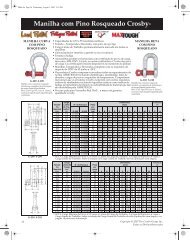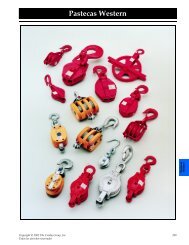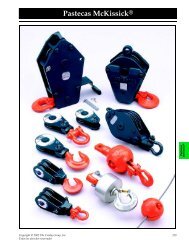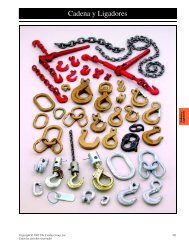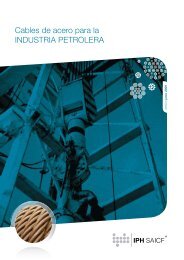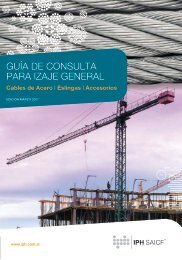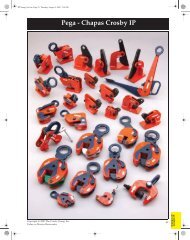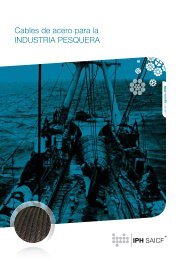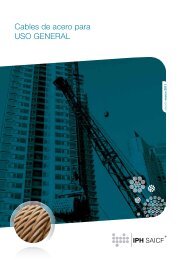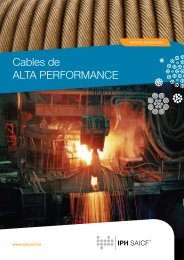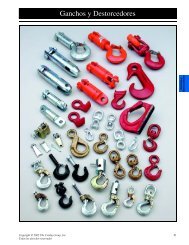Untitled
Untitled
Untitled
Create successful ePaper yourself
Turn your PDF publications into a flip-book with our unique Google optimized e-Paper software.
2<br />
Wire ropes<br />
for land-based rigs<br />
The land-based drilling rigs used in the oil drilling<br />
are one of the best challenges for a steel<br />
rope; therefore the ropes to be used must be<br />
specifically designed and manufactured for<br />
this application.<br />
IPH SAICF Quality Management System is API<br />
Std Q1 certified, and its ropes show API 9a<br />
monogram according to license Nº 0018 9a<br />
owned by IPH SAICF since 1989.<br />
These products are leaders in the Argentine<br />
land-based drilling market and are regularly<br />
exported to highly developed countries in<br />
terms of oil industry.<br />
Lic. N 0018 9a<br />
3<br />
4<br />
5<br />
6<br />
8<br />
9<br />
10<br />
11<br />
12<br />
13<br />
14<br />
15<br />
Summary<br />
IPH 619API<br />
Data sheet.<br />
IPH GPC<br />
Data sheet.<br />
IPH GPCL<br />
Data sheet.<br />
USER TOOLS<br />
Slip and cutoff plan.<br />
USER TOOLS<br />
Visual inspection of the drilling rope.<br />
USER TOOLS<br />
Service factors of oil ropes.<br />
IPH 67API<br />
Data sheet.<br />
USER TOOLS<br />
Recommendations to use sand line.<br />
Sand line visual inspection.<br />
IPH 636<br />
Technical data.<br />
Recommendations to use winch truck rope.<br />
IPH SERVICE<br />
TIPS<br />
COMPANY<br />
San Miguel Manufacturing Plant,<br />
Buenos Aires, Argentina.
IPH 619API<br />
3<br />
The main rope of the rig, or drilling line, is subject to high<br />
stresses combined with demanding sizes of sheaves and<br />
drums.<br />
IPH 619API wire rope, suitable for any rig, exceeds the<br />
lifetime recommended by API RP 9b Standard, providing<br />
high performance and optimizing cost.<br />
DATA SHEET<br />
Construction: 6x19 Seale (1 + 9 + 9).<br />
Core: Independent wire rope<br />
Default finish: Bright, lubricated.<br />
Lubrication: Hot applied in all wires of both the<br />
core and strands.<br />
Lubricant: Mineral base with anti-corrosion,<br />
adherence and extreme pressure additives,<br />
among others.<br />
Default resistance: EIP grade, grade EEIP<br />
upon request.<br />
Lay: Regular right or left, upon request.<br />
Manufacturing standard: Meets or exceeds<br />
API 9a Standard.<br />
Minimum breaking load<br />
Diameter Approx. Mass<br />
IPS Grade<br />
EIP Grade<br />
(mm) (kg/m) (kgf) (kN) (kgf) (kN)<br />
22,20<br />
2,09<br />
36097<br />
354<br />
39768<br />
390<br />
25,40<br />
2,76<br />
46905<br />
460<br />
51596<br />
506<br />
28,60<br />
3,49<br />
58937<br />
578<br />
64852<br />
636<br />
31,80<br />
4,31<br />
72499<br />
711<br />
79739<br />
782<br />
34,90<br />
5,20<br />
87081<br />
854<br />
96156<br />
943<br />
38,10<br />
6,20<br />
102988<br />
1010<br />
113184<br />
1110<br />
41,30<br />
7,28<br />
121014<br />
1187<br />
132996<br />
1304<br />
For other constructions, diameters or resistances do not hesitate to contact us.
4<br />
IPH GPC<br />
IPH GPC rope, with compacted strands, offers 20%<br />
ton-mile over IPH 619 API and minimizes the loss<br />
of diameter under stress. Since the breaking load<br />
is higher, the service factor increases; therefore, it<br />
is recommended for deep drilling with naturally low<br />
service factors.<br />
DATA SHEET<br />
Construction: 6x26 Warrington Seale with<br />
compacted strands (1 + 5 + 5/5 + 10).<br />
Core: Independent steel cord (IWRC).<br />
Default finish: Bright lubricated.<br />
Lubrication: Hot application in all wires of the<br />
core and strands.<br />
Lubricant: Mineral base with anti-corrosion,<br />
adherence and extreme pressure additives,<br />
among others.<br />
Default resistance: EIP grade, EEIP grade<br />
upon request.<br />
Lay: Regular right or left, upon request.<br />
Manufacturing standard: Meets or exceeds<br />
API 9a standard requirements.<br />
Differential characteristics: Larger resistant<br />
metallic area, with higher breaking load, better<br />
support on pulleys, higher resistance to<br />
abrasion, minimum loss of diameter under wear.<br />
Minimum breaking load<br />
Diameter Approx. Mass<br />
IPS Grade<br />
EIP Grade<br />
(mm) (kg/m) (kgf) (kN) (kgf)<br />
(kN)<br />
28,60<br />
3,58<br />
65262<br />
640<br />
71875<br />
704<br />
31,80<br />
4,42<br />
80683<br />
791<br />
88859<br />
871<br />
34,90<br />
5,33<br />
97180<br />
953<br />
107028<br />
1049<br />
38,10<br />
6,35<br />
115818<br />
1136<br />
127555<br />
1250<br />
41,30<br />
7,46<br />
136090<br />
1335<br />
149882<br />
1468<br />
For other constructions, diameters or resistances do not hesitate to contact us.
IPH GPCL<br />
5<br />
IPH GPCL rope, with compacted strands and plastic<br />
coated core is an improved alternative for deep drilling<br />
with low service<br />
factors and hard soil or other operating difficulties.<br />
It offers higher breaking load, with lower loss of diameter<br />
under stress and great stability in the drum. It reates 20%<br />
ton- mile more than IPH 619API.<br />
DATA SHEET<br />
Construction: 6x26 Warrington Seale with<br />
compacted strands (1 + 5 + 5/5 + 10).<br />
Core: Independent wire rope (IWRC) with<br />
thermo-plastic process.<br />
Default finish: Bright lubricated.<br />
Lubrication: Hot application in all wires of the<br />
core and strands.<br />
Lubricant: Mineral base with anti-corrosion, adherence<br />
and extreme pressure additives, among<br />
others.<br />
Default resistance: EIP grade, EEIP grade<br />
upon request.<br />
Lay: Regular right or left, upon request.<br />
Manufacturing standard: Meets or exceeds<br />
API 9a standard requirements.<br />
Differential characteristics: Higher breaking<br />
load due to metallic area and core coating,<br />
higher resistance to abrasion, minimum loss of<br />
diameter under wear.<br />
Minimum breaking load<br />
Diameter Approx. Mass<br />
IPS Grade<br />
EIP Grade<br />
(mm) (kg/m) (kgf) (kN) (kgf)<br />
(kN)<br />
28,60<br />
3,64<br />
68850<br />
675<br />
75786<br />
743<br />
31,80<br />
4,51<br />
85170<br />
835<br />
93738<br />
919<br />
34,90<br />
5,43<br />
103020<br />
1010<br />
113220<br />
1110<br />
38,10<br />
6,47<br />
122400<br />
1200<br />
134640<br />
1320<br />
41,30<br />
7,60<br />
143824<br />
1410<br />
158206<br />
1551<br />
For other constructions, diameters or resistances do not hesitate to contact us.
6<br />
USER TOOLS<br />
Slip and<br />
cutoff plan<br />
The run and cutoff program must be set according to:<br />
• API recommendations about working limits.<br />
• Correction of these limits according to the service<br />
factor (API).<br />
• Adjustment of limits to specific situations.<br />
• Optimization of the run and cutoff program through<br />
systematized experience.<br />
SIMPLIFIED LIMIT TABLES<br />
API recommendations about working limits cover a great number of cases and variables.<br />
The following simplified tables include the most typical values of work limits in ton-mile, and the<br />
corresponding cutoff lengths. Although these combinations apply to many cases, we recommend<br />
to consider the contents of “Explanatory Notes” for their application.<br />
Diameter Work limit for cutoff (I) Cutoff length (II)<br />
(in) (ton.mil) (m)<br />
7/8<br />
1<br />
1 1/8<br />
1 1/4<br />
1 3/8<br />
350<br />
500<br />
800<br />
1200<br />
2000<br />
18<br />
18<br />
24<br />
30<br />
35<br />
I. For Service Factor =5<br />
II. It is recommended to adjust the length to the specific characteristics of the rig.<br />
EXPLANATORY NOTES<br />
IPH SAICF introduces this simplified table<br />
considering these premises:<br />
• The reference Standard for this table is<br />
API RP 9b.<br />
• The simplified table shows the values<br />
for “light duty” according to the Standard.<br />
• IPH 619API ropes from IPH SAICF generally<br />
meet these values or even higher in all types<br />
of work, considering correction due to Service<br />
factor.<br />
• The length to be cut are approximations that<br />
result from the average of values
7<br />
The table ton-mile must<br />
be multiplied by the<br />
factor obtained<br />
in the graph.<br />
(This correction is not performed<br />
when working with the<br />
compensated ton-miles system)<br />
corresponding to most frequent drum and<br />
mast sizes. It is convenient to adjust these<br />
lengths to the specific characteristics of<br />
each rig.<br />
• Anyway, as set in the Standard, these limit<br />
values are guidelines, and selecting a ton-mile<br />
limit to use is up to the Drilling Contractor.<br />
• 7/8” rope is not included in the Standard.<br />
IPH suggests a limit obtained by quadratic<br />
extrapolation of 1’’.<br />
• 7/8 y 1” ropes: IADC Standard and Manual<br />
highlight that in light operations, with low<br />
ton-mile total, the speed determines the rope<br />
wear; therefore, attention should be paid to the<br />
rope visual condition.<br />
• As any simplification, this tables loses some<br />
accuracy in contrast with original API RP 9b<br />
tables. IPH has made its best effort to<br />
introduce a useful and adequate tool for the<br />
Oil Industry. However, in the event of doubt,<br />
the complete tables of the Standard should<br />
prevail.
8<br />
USER TOOLS<br />
Visual inspection<br />
of the drilling line<br />
The drilling rope care involves two essential pillars:<br />
• Strict compliance with the run and cutoff program<br />
• Visual inspection<br />
To keep a safe operation, the rope must be cut as stated in<br />
the run and cutoff program, whatever takes place first.<br />
Visual inspection consists in the following observations:<br />
(adapted from ISO 4309):<br />
• Loss of diameter: The maximum allowed is 7%; after this<br />
situation it becomes critical.<br />
• Count of broken wires:<br />
- In a length equal to 6 diameters of rope, between 3<br />
and 6 broken wires is considered critical, accord<br />
ing to the expected service demand.<br />
- In a length of 30 diameters of rope, between 6 and<br />
12 broken wires is considered critical, according<br />
to the expected service demand.<br />
• Localized anomalies: very close broken wires in only one<br />
strand (3 are critical), kinks, knots or other permanent<br />
deformations. Any of these situations is considered critical.<br />
Visual inspection interacts with the run and cutoff<br />
program. If visual inspection shows that the cutoff rope is<br />
in good conditions, this situation must be considered for<br />
the systematic optimization of the run and cutoff program;<br />
however, do not make changes in the run and cutoff program<br />
based in few observations and short time. Again: if the run<br />
and cutoff program indicates to slip rope, this instruction<br />
must be followed, regardless of its condition. It is<br />
expected that the rope is far from the critical condition.<br />
On the contrary, if the visual inspection shows that the rope is<br />
in quasi-critical conditions, it must be cut until eliminating the<br />
section in bad conditions. This situation is not probable if the<br />
run and cutoff program is well set and met.
9<br />
Oil ropes<br />
service factors<br />
Service Factor results from dividing the minimum breading<br />
load of the rope by the real load on it.<br />
The Service Factor is characteristic of each operation and<br />
plays an important role in implementing the run and cutoff<br />
program.<br />
Line<br />
Drilling line<br />
Sand line<br />
SF<br />
recommended<br />
5<br />
5<br />
SF<br />
minimum allowed<br />
3 in deep drilling<br />
2 when setting casing<br />
3<br />
Mast raising line<br />
5<br />
2.5<br />
Auxiliary hoisting<br />
winch rope<br />
5<br />
3 (not recommended)<br />
Winch truck rope<br />
Source: API RP 9b Standard<br />
5<br />
API does not specify. Experience indicates<br />
a minimum of 2.5 with extreme precautions.
10<br />
IPH 67API<br />
The secondary wire rope in a workover rig is the so<br />
called “sand line” or “swabbing line” (when used for<br />
production). The 6x7 construction, with highly resistant<br />
synthetic fiber, is the most used for this application,<br />
because of its high resistance to abrasion and corrosion<br />
and its low initial cost.<br />
DATA SHEET<br />
Construction: 6x7.<br />
Core: Polypropylene fiber acid- resistant.<br />
Default finish: Bright, lubricated.<br />
Lubrication: Hot application on all strand wires.<br />
Lubricant: Mineral base with anti-corrosion,<br />
adherence and extreme pressure additives,<br />
among others.<br />
Default resistance: IPS grade.<br />
Lay: Regular right or left, upon request.<br />
Manufacturing standard: Meets or exceeds<br />
API 9a standard.<br />
Soul for high temperature: Over 80ºC the polypropylene<br />
soul can start plastification; therefore,<br />
in non-frequent cases of high temperatures, the<br />
rope with steel core can be supplied.<br />
Minimum breaking load<br />
Diameter Approx. Mass<br />
IPS Grade<br />
EIP Grade<br />
(mm) (kg/m) (kgf) (kN) (kgf)<br />
(kN)<br />
14.30<br />
0.47<br />
11828<br />
116<br />
12950<br />
127<br />
15.90<br />
0.58<br />
14377<br />
141<br />
15805<br />
155<br />
For other constructions, diameters or resistances do not hesitate to contact us.
USER TOOLS<br />
11<br />
Recommendations<br />
to use the sand<br />
line rope<br />
These are the main stresses of the sand line rope:<br />
• Strong abrasion due to contact with the walls of the well.<br />
• Strong corrosion due to the attack of the well liquids<br />
(many times acid).<br />
• Shock unloading, which may cause deformations, knots or<br />
tangles.<br />
This rope calls for careful operation with these main factors:<br />
• Neat winding on the drum, using an appropriate spooling<br />
device.<br />
• Careful speed handling.<br />
• Rinse and re-lubrication when working with acids (at the<br />
contractor’s discretion).<br />
Sand line rope duration is highly dependent from the characteristics<br />
of the well and the operator’s skills.<br />
Sand line rope<br />
visual inspection<br />
Sand line rope visual inspection is subject to general<br />
standards of any type of rope, with these specific<br />
considerations: (adapted from ISO 4309):<br />
• Loss of diameter in the most worn area:<br />
maximum accepted 8%.<br />
• Broken wires in the most worn area: In a length of 6 times<br />
the diameter, the accepted maximum is 3 broken wires and<br />
not in the same strand.<br />
Other visual criteria:<br />
• kinks, knots or other permanent deformations resulting from<br />
tangles.<br />
• Weld splash or other signs of burning.<br />
• Protrusion of the fiber core.<br />
• Loss of diameter due to lack of core. This is a very severe<br />
situation in which the rope loses the circular shape of the<br />
section. The rope must be immediately removed from<br />
operation.<br />
• Advanced corrosion. Although the total rope diameter is<br />
correct, there may be irregularities in the diameters of<br />
individual wires resulting from corrosion.
12<br />
IPH 636<br />
Winch truck ropes are always subject to high demands<br />
due to high loads and the reduced drum and roll size.<br />
IPH 636 rope provides high traction and crushing<br />
resistance together with great flexibility at a low cost.<br />
DATA SHEET<br />
Core: Steel.<br />
Steel grade: 1960 N/mm2.<br />
Lay: Normally right. Left can be provided<br />
upon request.<br />
Surface finish: Bright, lubricated.<br />
Diameter Approx. Mass Minimum breaking load<br />
(mm) (kg/m) (kgf)<br />
(kN)<br />
22<br />
1,98<br />
34500<br />
338<br />
26<br />
2,76<br />
48200<br />
472<br />
28<br />
3,21<br />
55800<br />
547<br />
32<br />
4,19<br />
73000<br />
715
USER TOOLS<br />
13<br />
Recommendations<br />
to use the winch<br />
truck rope<br />
The different performance of the rope is evident when handled<br />
by an expert operator or a careless or new one. The keys for<br />
safe use are:<br />
• Lift the load softly, with no jerks or shock loads.<br />
• Keep a strict inspection plan. The critical sections are: the<br />
joint with the tail-chain, the inner lays on the drum and the<br />
section overpassing on the rear roll.<br />
• During both installation and operation the rope must be<br />
winded with stress, never loose.<br />
• Winded with stress, the coils together.<br />
IPH SERVICE<br />
We are your<br />
partner in<br />
reducing your<br />
operation costs<br />
Exclusive services for regular IPH products users:<br />
• Stock planning and “just in time” delivery.<br />
• Advice on the application of specific standards<br />
(for example, API RP 9b).<br />
• Tailor made and optimized slip and cutoff programs.<br />
• Advice on the hoisting risk analysis.<br />
• Advice in person in the well or virtual in our website.<br />
• Training seminars for the staff and crew.
14<br />
TIPS<br />
Control of the<br />
condition of<br />
the sheave grooves<br />
• The condition of the sheave exerts a determinant influence<br />
on the steel rope performance.<br />
• The diameter and condition of the conduit must be<br />
periodically controlled, as well as alignment, offset and<br />
freedom of the roller.<br />
• The condition of the conduit is controlled with gauges.<br />
GAUGE<br />
PULLEY IN<br />
GOOD CONDITION<br />
GAUGE<br />
WEAR OF THE PULLEY<br />
CONDUIT<br />
Reels movement<br />
with the forklift<br />
CORRECT<br />
The forks must take the<br />
spool by the wood and at<br />
the bottom part.<br />
INCORRECT<br />
These ways of taking the<br />
spool are incorrect and<br />
dangerous.<br />
Handling of<br />
the steel rope<br />
CORRECT<br />
INCORRECT<br />
Turn the spool.<br />
Roll the roll.<br />
WARNING<br />
The fail of a wire rope or sling can result in severe damages, even death.<br />
The wire rope or sling can fail in cases of damages, abuse, incorrect use or maintenance.<br />
Inspect the steel rope or sling before every use.<br />
Obtain information from the manufacturer and IRAM, ISO, API or equivalent standards.<br />
Source: Wire Rope Thecnical Board
COMPANY<br />
15<br />
Over 60 years<br />
of ongoing production<br />
and renewal<br />
Born 60 years ago in the Northern area of Greater Buenos<br />
Aires, Argentina, IPH SAICF has currently consolidated itself<br />
as the largest Argentine producer of wire ropes, and one of<br />
the most important ones in Latin America. 2009 finds ourselves<br />
going through an expansion period, satisfying a big<br />
portion of the Argentine market and exporting high tech products<br />
to almost 20 countries in America, Europe and Asia.<br />
IPH was one of the first rope factories in America that complied<br />
with ISO 9000 standard together with other prestigious<br />
certifications such as API, Lloyd’s, IRAM, etc.<br />
IPH SAICF technology makes it possible to produce a wide<br />
variety of steel ropes, including:<br />
• Compacted ropes.<br />
• 8 strand ropes.<br />
• Rotation resistant wire ropes.<br />
• Thermoplastic coated steel core ropes.<br />
• Steel-polymer combination wire ropes.<br />
• Extra heavy galvanized wire ropes.<br />
• Diameters up to 80 mm and spool up to 20 ton.<br />
• Specifically developed products for various needs.
16<br />
HEADQUARTERS<br />
Av. Arturo Illía 4001<br />
B1663HRI - San Miguel<br />
Buenos Aires<br />
Argentina<br />
Sales<br />
T: (54.11) 4469-8111<br />
F: (54.11) 4469-8101<br />
ventas@iph.com.ar<br />
Administration<br />
T: (54.11) 4469-8100<br />
F: (54.11) 4469-8101<br />
info@iph.com.ar<br />
BRAZIL SUBSIDIARY<br />
Av. Presidente Wilson 1648<br />
Mooca - SP - CEP 03107.001<br />
Brasil<br />
Tel/Fax: (55.11) 2272-3433<br />
iph@iphdobrasil.com.br<br />
www.iphdobrasil.com.br




